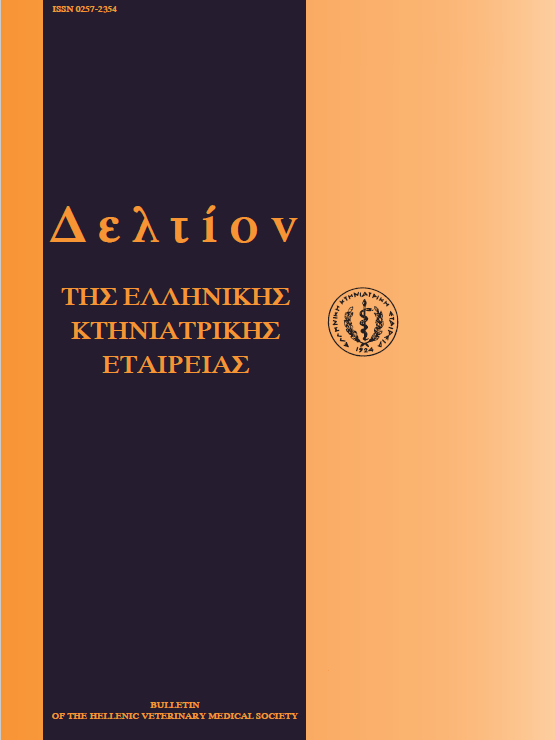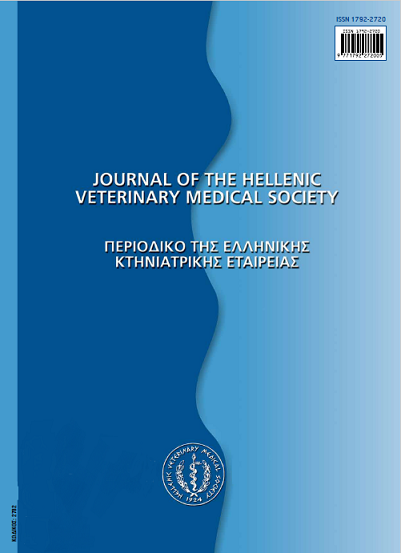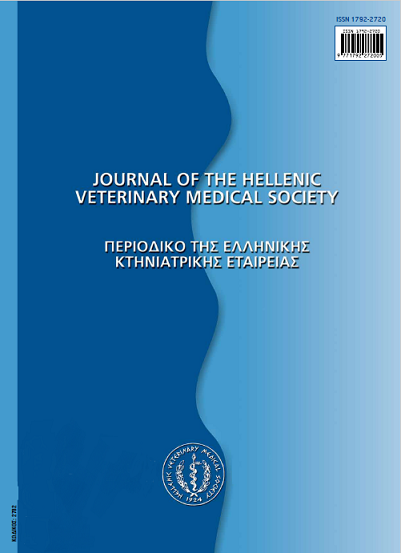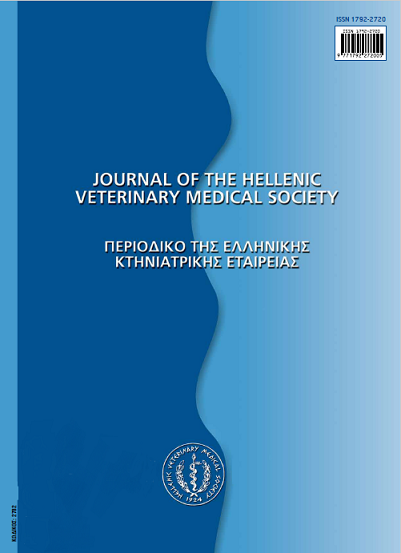Επιπολασμος αντισωμάτων έναντι της Coxiella burnetii στο γάλα και στον ορό και συσχέτιση με αναπαραγωγικούς δείκτες σε εκτροφές αγελάδων γαλακτοπαραγωγής της Κεντρικής και Βόρειας Ελλάδας
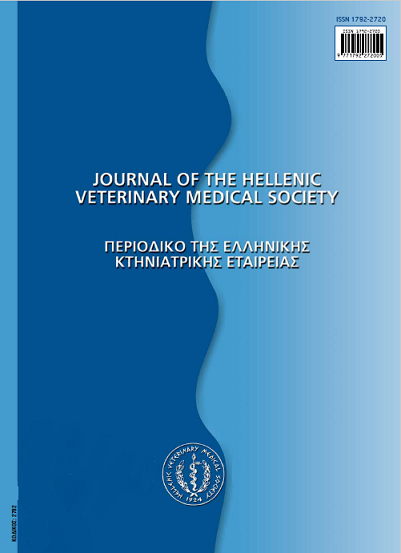
Περίληψη
Στην εργασία αυτή ερευνήθηκε για πρώτη φορά στην Ελλάδα το ποσοστό προσβολής (επιπολασμός) από C.burnetii σε αγελάδες γαλακτοπαραγωγής. Ογδόντα εκτροφές αγελάδων της βόρειας και κεντρικής Ελλάδας συμμετείχαν οικειοθελώς στην έρευνα. Δείγματα γάλακτος συλλέχθηκαν από τη δεξαμενή γάλακτος της μονάδας και εξετάστηκαν για την παρουσία αντισωμάτων έναντι της C. burnetii με τη μέθοδο της ELISA. Αναλόγως του τίτλου των αντισωμάτων, οι μονάδεςκατατάχθηκαν σε 5 κατηγορίες: αρνητικές, 1,2,3 και 4. Για να ελέγξουμε το βαθμό προσβολής σε επίπεδο εκτροφής, επιλέχθηκαν2 μονάδες από κάθε κατηγορία από τα ζώα των οποίων συλλέχθηκαν δείγματα αίματος τα οποία εξετάστηκαν, όπως και ταδείγματα γάλακτος, για παρουσία αντισωμάτων. Στις μονάδες αυτές έγινε σύγκριση ορισμένων αναπαραγωγικών δεικτών μεταξύ οροθετικών και οροαρνητικών μονάδων. Επιπλέον, σε μια ομάδα κατηγορίας 3, συγκρίθηκαν οι αναπαραγωγικοί δείκτες σε ζεύγη οροαρνητικών - οροθετικών ζώων. Από την εξέταση των δειγμάτων γάλακτος, βρέθηκαν συνολικά 28 θετικέςμονάδες (35%), από τις οποίες οι 21 ανήκαν στις κατηγορίες 3 και 4. Το ποσοστό των οροθετικών ζώων στις εκτροφέςπαράλλασσε από 4.9% έως και 46.3%, ενώ οροθετικά ζώα ανιχνεύθηκαν και σε εκτροφές οι οποίες, με βάση την εξέταση τουγάλακτος, είχαν αρχικώς χαρακτηριστεί ως αρνητικές. Δε βρέθηκαν διάφορες στα ποσοστά αποβολών και στον απαιτούμενο αριθμό ΤΣ ανά εγκυμοσύνη. Διάφορες εντοπίστηκαν σε διάφορους αναπαραγωγικούς δείκτες, όμως αυτές μάλλον αποτυπώνουνδιαφορετικές αναπαραγωγικές πρακτικές και δε θα έπρεπε να αποδοθούν στην προσβολή από C. burnetii. Τα αποτελέσματα της παρούσας μελέτης δείχνουν ότι η προσβολή των αγελάδων γαλακτοπαραγωγής από C. burnetii είναι μάλλον υποκλινική ή ασυμπτωματική και προκαλεί ελάχιστες - ίσως καμία- οικονομικές απώλειες στον κτηνοτρόφο. Με δεδομένο, όμως, ότι η νόσος μεταδίδεται στον άνθρωπο (ζωοανθρωπονόσος) και η διασπορά της μπορεί να γίνει εύκολα, θεωρούμε ότι είναι επιβεβλημένη η διενέργεια, σε εθνικό επίπεδο, συστηματικής διερεύνησης του βαθμού προσβολής σε όλα τα είδη των μηρυκαστικών,με σκοπό τη λήψη μέτρων για τον περιορισμό ή/και την εκρίζωση της.
Λεπτομέρειες άρθρου
- Πώς να δημιουργήσετε Αναφορές
-
DOVOLOU (Ε. ΝΤΟΒΟΛΟΥ) E., TSILIGIANNI (Θ. ΤΣΙΛΙΓΙΑΝΝΗ) T., VOUZARAS (Δ. ΒΟΥΖΑΡΑΣ) D., & AMIRIDIS (Γ.Σ. ΑΜΟΙΡΙΔΗΣ) G. S. (2017). Επιπολασμος αντισωμάτων έναντι της Coxiella burnetii στο γάλα και στον ορό και συσχέτιση με αναπαραγωγικούς δείκτες σε εκτροφές αγελάδων γαλακτοπαραγωγής της Κεντρικής και Βόρειας Ελλάδας. Περιοδικό της Ελληνικής Κτηνιατρικής Εταιρείας, 62(4), 314–319. https://doi.org/10.12681/jhvms.14861
- Τεύχος
- Τόμ. 62 Αρ. 4 (2011)
- Ενότητα
- Research Articles
Οι συγγραφείς των άρθρων που δημοσιεύονται στο περιοδικό διατηρούν τα δικαιώματα πνευματικής ιδιοκτησίας επί των άρθρων τους, δίνοντας στο περιοδικό το δικαίωμα της πρώτης δημοσίευσης.
Άρθρα που δημοσιεύονται στο περιοδικό διατίθενται με άδεια Creative Commons 4.0 Non Commercial και σύμφωνα με την άδεια μπορούν να χρησιμοποιούνται ελεύθερα, με αναφορά στο/στη συγγραφέα και στην πρώτη δημοσίευση για μη κερδοσκοπικούς σκοπούς.
Οι συγγραφείς μπορούν να καταθέσουν το άρθρο σε ιδρυματικό ή άλλο αποθετήριο ή/και να το δημοσιεύσουν σε άλλη έκδοση, με υποχρεωτική την αναφορά πρώτης δημοσίευσης στο J Hellenic Vet Med Soc
Οι συγγραφείς ενθαρρύνονται να καταθέσουν σε αποθετήριο ή να δημοσιεύσουν την εργασία τους στο διαδίκτυο πριν ή κατά τη διαδικασία υποβολής και αξιολόγησής της.



